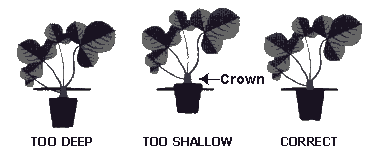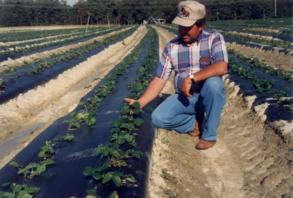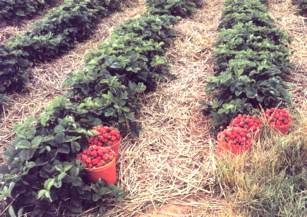|
|
||||
| Home | Prices | Planting Guide | Planting Zones Map | ||||
|
|
||||
| Home | Prices | Planting Guide | Planting Zones Map | ||||
 After
preparing a good location, you are ready to start planting your strawberry
plugs. Make sure your plugs are watered thoroughly before planting.
Space your plugs 12 -18 inches apart in the row. Optimal spacing
between rows is 3 - 4 feet apart for maximum air movement and sunlight.
Set plants in the row with the root ball facing straight down. The
middle of the crown should be level with the top of the soil. Soil
should be watered after planting to set the strawberry plants in the ground
(Avoid watering plants directly. Sprinklers or drip irrigation works best).
After the initial watering, the soil will settle and the soil line should
be even with the bottom of the crown as indicated in the picture.
After
preparing a good location, you are ready to start planting your strawberry
plugs. Make sure your plugs are watered thoroughly before planting.
Space your plugs 12 -18 inches apart in the row. Optimal spacing
between rows is 3 - 4 feet apart for maximum air movement and sunlight.
Set plants in the row with the root ball facing straight down. The
middle of the crown should be level with the top of the soil. Soil
should be watered after planting to set the strawberry plants in the ground
(Avoid watering plants directly. Sprinklers or drip irrigation works best).
After the initial watering, the soil will settle and the soil line should
be even with the bottom of the crown as indicated in the picture.

At planting time, the soil should be weed free. After planting, weekly
cultivation is recommended to remove weeds when they are small. A method
call plasticulture can also be used for weed control. Place black plastic
(shown in picture) over raised strawberry plant beds and plant strawberry plugs
through holes punched in the top of the plastic. This will greatly reduce
weeds from growing around your strawberry plants (without having to cultivate
the soil), help conserve ground moisture, and keep fruit clean. This method
is widely used by growers on the east coast.
 Strawberries
are perennial plants that must endure the elements throughout the winter
to survive. They are sensitive however to cold temperatures, and plants
may experience winter damage if the crowns reach negative temperatures
(F). Mulching strawberry plants helps prevent quick freezing
and thawing which can affect plant survival. The mulch maintains a large
volume of dead air spaces, and as a result, it helps to insulate warm air
near the plant through cooler periods. The rough surface of the mulch can
also help to trap and hold snow that might have been otherwise blown away.
Mulching also keeps weeds down, conserves moisture, helps keep fruit clean,
and adds humus to the soil.
Strawberries
are perennial plants that must endure the elements throughout the winter
to survive. They are sensitive however to cold temperatures, and plants
may experience winter damage if the crowns reach negative temperatures
(F). Mulching strawberry plants helps prevent quick freezing
and thawing which can affect plant survival. The mulch maintains a large
volume of dead air spaces, and as a result, it helps to insulate warm air
near the plant through cooler periods. The rough surface of the mulch can
also help to trap and hold snow that might have been otherwise blown away.
Mulching also keeps weeds down, conserves moisture, helps keep fruit clean,
and adds humus to the soil.
Several types of materials can be used for mulching like wheat, salt
hay, or oat straw. Wood chips can also be used, but it is best to avoid
materials like leaves because they tend to mat down and smother plants.
You can also run into problems when using a material that is too light
because of the increased probability that it will be blown away by the
wind. You should mulch strawberry plants in mid to late November
when the plants have started to go dormant and air temperatures are generally
low enough to reduce the susceptibility to any diseases. A rate of
14 - 16 pounds of wheat or oat straw per 100 square feet should provide
a 2 inch cover and adequate protection. Remove mulch from the top
of the crowns in the spring when new growth starts. Avoid removing the
mulch too early, because you may accelerate blossoming and increase the
susceptibility to frost damage. Leaving the mulch in the aisles will
help keep the fruit clean.
Home | Pricing and Shipping | Planting Guide | Plant Hardiness Zones
About Us | Greenhouse and Garden Products | Strawberry Info Links
Copyright Aarons Creek Farms, Inc. All Rights Reserved.